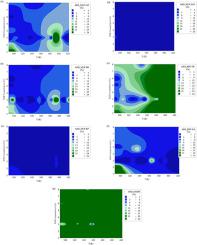Journal of Petroleum Science and Engineering Pub Date : 2020-07-25 , DOI: 10.1016/j.petrol.2020.107617 Mehdi Mahdaviara , Alireza Rostami , Abbas Helalizadeh , Khalil Shahbazi

|
The Viscoelastic Surfactant (VES) based self-diverting acids, the recent generation of the acid diverters, have been widely applied to alleviate the non-uniform distribution of the treatment fluids into the heterogeneous porous medium. Measuring the rheological characteristics of the aforesaid acids is an unavoidable step in designing an acid stimulation project. The purpose of this study is to generate smart soft-computing models for prognosticating the viscosity of VES-based acids as a function of five independent variables including VES concentration, temperature, shear rate, pH value and the concentration of the Ca2+ (or CaCl2). Robust types of artificial intelligence methodologies including Multilayer Perceptron (MLP), Radial Basis Function (RBF), and Group Method of Data Handling (GMDH) were trained to achieve both computer-based and user-accessible models for the scope of this research. The MLP approach was optimized with four diverse algorithms including Resilient Backpropagation (RB), Bayesian Regularization (BR), Levenberg-Marquardt (LM), and Scaled Conjugate Gradient (SCG). The Differential Evolution (DE) and Independent Component Analysis (ICA) techniques were utilized to precisely tune the control parameters of the RBF network. Accordingly, several models were generated over three experimental data sets collected from the literature. The truthfulness and reliability of the developed models were assessed by employing several statistical parameters and graphical analyses. According to the results, all the proposed smart models were thoroughly victorious for predicting the VES-based acid viscosity. The MLP-SCG strategy outperformed other algorithms with Root Mean Square Error (RMSE), Average Absolute Relative Deviation (AARD), and R2 values of 0.0025, 0.6265%, and 0.9998, respectively. The so-called outliers analysis reveals that all datapoints used for modeling are located in the applicability domain leading to the database validity and model reliability. Furthermore, a comparison between the smart models proposed here against literature traditional correlations demonstrates the superiority of the intelligent models for the scope of this study. At last, it should be expressed that the created strong tools here could be of high weight for the successful design and implementation of matrix acidizing.
中文翻译:

粘弹性表面活性剂自转移酸粘度的智能建模
基于粘弹性表面活性剂(VES)的自转移酸,是最近的酸转移剂,已被广泛应用于减轻处理液向非均相多孔介质中的不均匀分布。测量上述酸的流变特性是设计酸增产方案中不可避免的步骤。这项研究的目的是生成智能的软计算模型,以预测VES基酸的粘度与五个独立变量(包括VES浓度,温度,剪切速率,pH值和Ca 2+(或氯化钙2)。包括多层感知器(MLP),径向基函数(RBF)和数据处理组方法(GMDH)在内的健壮类型的人工智能方法都经过了培训,以实现基于计算机的模型和用户可访问的模型。MLP方法通过四种不同的算法进行了优化,包括弹性反向传播(RB),贝叶斯正则化(BR),Levenberg-Marquardt(LM)和缩放共轭梯度(SCG)。利用差分进化(DE)和独立成分分析(ICA)技术来精确调整RBF网络的控制参数。因此,在从文献收集的三个实验数据集上生成了几个模型。通过采用几个统计参数和图形分析来评估所开发模型的真实性和可靠性。根据结果,所有提出的智能模型在预测基于VES的酸粘度方面均大获全胜。MLP-SCG策略的均方根误差(RMSE),平均绝对相对偏差(AARD)和R优于其他算法2个值分别为0.0025、0.6265%和0.9998。所谓的离群值分析表明,用于建模的所有数据点都位于适用性域中,从而导致数据库的有效性和模型的可靠性。此外,本文提出的智能模型与文献传统相关性之间的比较证明了智能模型在本研究范围内的优越性。最后,应该表示,此处成功创建的强大工具对于成功设计和实施基质酸化具有很高的意义。











































 京公网安备 11010802027423号
京公网安备 11010802027423号